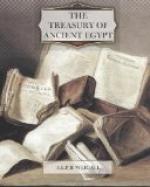The Egyptians often amused themselves by drawing comic pictures and caricatures, and there is an interesting series still preserved in which animals take the place of human beings, and are shown performing all manner of antics. One sees a cat walking on its hind legs driving a flock of geese, while a wolf carrying a staff and knapsack leads a herd of goats. There is a battle of the mice and cats, and the king of the mice, in his chariot drawn by two dogs, is seen attacking the fortress of the cats. A picture which is worthy of Edward Lear shows a ridiculous hippopotamus seated amidst the foliage of a tree, eating from a table, whilst a crow mounts a ladder to wait upon him. There are caricatures showing women of fashion rouging their faces, unshaven and really amusing old tramps, and so forth. Even upon the walls of the tombs there are often comic pictures, in which one may see little girls fighting and tearing at each others’ hair, men tumbling one over another as they play, and the like; and one must suppose that these were the scenes which the owner of the tomb wished to perpetuate throughout the eternity of Death.
The Egyptians took keen delight in music. In the sound of the trumpet and on the well-tuned cymbals they praised God in Egypt as merrily as the Psalmist could wish. The strings and the pipe, the lute and the harp, made music at every festival—religious, national, or private. Plato tells us that “nothing but beautiful forms and fine music was permitted to enter into the assemblies of young people” in Egypt; and he states that music was considered as being of the greatest consequence for its beneficial effects upon youthful minds. Strabo records the




